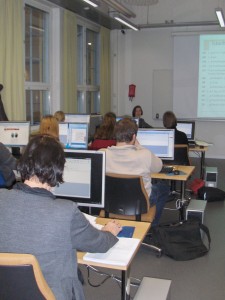Jari Böling, Xiaolu Wang, Johan Ehrstedt and Heidi Henriksson
This blog post was written as a part of our coursework assignment for the second module of university pedagogics.
Academic freedom is considered important by the universities, and the purpose of this blogpost is to take view on it from the student’s perspective, not forgetting costs that of interests students as indirectly paying customers. What first come to mind are time limits on studies, which were introduced in the Bologna reform. The nominal time for a Master’s degree is 5 years, and that can be extended to 8 years, but no longer. Limits have been introduced to put pressure on students to graduate, and the university financing system is also constructed so that every enrolled student that don’t take 55 credits per year cost something for the university (~1100€/year, compared to that they would be thrown out). During our University Pedagogy course we had a discussion where we discussed a fee after the fifth year, in order to more pressure on the students. At the course we were quite positive towards this, but afterwards we realized that there are many problems. Money is typically very important for students, so they will start taking easier and safer paths in their studies, and avoid social activities that take precious time. Both are bad, students should be free to be creative, and to explore what the university has to offer. And of course social skills are extremely important [1]. Students should be given the freedom to mature into professionals, and pressing the students into a single mold is not the way to go. But still a bit of pressure is probably necessary for efficiency reasons, but we do think that the current time limit is enough, and gives most students enough time.
Another related thing is the student’s freedom to participation and critical thinking. Today’s efficiency thinking leads to fewer lectures for larger groups and even purely reading courses. This of course makes it harder for students to actively be involved, and to get peer instruction, which we do think is not good. On the other hand university teachers are encouraged to study pedagogy nowadays, which probably has a positive impact in this issue.
But how about the academic freedom of the teacher, how does that affect the students? Teachers have the freedom to do academic research, and to teach based on that. Students on the other hand do hope that the teaching is relevant for them, and there is a bit of a conflict here, as research can be experimental and potentially not lead to anything relevant. And it can also be difficult to understand research, as it is ideally supposed to expand the limits of human knowledge. The compromise we think is to focus on the basics and established research, but also to teach and encourage scientific thinking, and to relate to own research when possible. It is not a good idea to teach students how to make an atomic bomb before they know the periodic table.
Universities are today under large pressure to publish or perish, which has some negative influences from a student perspective. In order to survive, university teachers often need to prioritize research in front of teaching. On top of that effectiveness in teaching is typically measured by quantity, which means effectiveness is on all counts increased by letting the students pass as easy as possible. Which might seem positive from a student perspective, but in order to survive the demands of their future work, we think it is good to put pressure on the students. A corporate research manager once said the following, when he was asked what he thought universities should teach: “The difficult stuff, that you never have time to learn when you work at a company. The easy stuff you can learn while you are working.”
And finally some words about costs, Pearlstein [2] notes that costs attending US universities have increased much more than consumer index (439% vs 106%, from 1983 to 2008). Similar numbers can also be found for Finland, Talouselämä [3] says that state funding of Finnish universities has increased by 44,6% from 2005 to 2015. During the same time, consumer index in Finland has increased by 21,6% [4]. So one can wonder can we really blame the state for the current financial situation in the universities, or should we also look in the mirror? What have we done with the 683 millions that the abovementioned 44,6% is in euros? In 2005 nobody talked about a financial crisis at universities. Have we misused our academic freedom? Let us take a closer look at the four things that is mentioned in [2] suggested for reining costs, maybe they can be applied in Finland as well.
- Cap administrative costs. Administration is what has increased the most in the US universities. Probably true as well in Finland.
- Operate year-round, five days a week. The former we do not fully agree with, summer exams does give better possibilities for studies during the summer, but we think students need time for working during summers, and summers are also the best time for doing research for university teachers. The latter was probably improved at ÅA by moving all exams to Fridays.
- Cheaper, better general education. A large portion of university courses are supposed to fulfill requirements of general education. The article claims that university courses are typically either focused on students majoring in a topic, or reflect the specific research interests of professors. Both serve the requirements of general education badly according to the article. As a remedy it is stated in [2] that “A university concerned about cost and quality would restructure general education around a limited number of courses designed specifically for that purpose — classes that tackle big, interesting questions from a variety of disciplines.” I think this was one of the purposes with the most recent reform of the Bachelors education at ÅA.
- More teaching, less (mediocre) research. The pressure to produce a lot of publications means less time for teaching. Seppo Aaltonen, professor at Aalto says that the pressure to publish and produce exams has at Aalto led to a dramatic increase especially in publications, but also to a large drop in innovations [5]. And we do think that students are more interested in innovations than in a large number of publications. One can also envy the statement of the leader of Bell Labs (currently owned by Nokia), when he was asked who decides what they should do in their research [6]: “Nobody. Our task is to think about the future. If we think that something will be important and valuable in the future, we have the right to investigate it”. It seems that the universities are more focused on short term income, so one wonders if we are on a path that leads us astray from our fundamental role.
Referenses
[1] Leah Jamieson (2015). Expanding the definition of engineering education [internet publication] http://depts.washington.edu/celtweb/pioneers-wp/?p=558, accessed 6.6 2016
[2] Pearlstein Steven (2015). Four tough things universities should do to rein costs. Washington Post, 25.11 2015. https://www.washingtonpost.com/opinions/four-tough-things-universities-should-do-to-rein-in-costs/2015/11/25/64fed3de-92c0-11e5-a2d6-f57908580b1f_story.html
[3] Mäntylä, Juha-Matti, 2016. Suuri huuto pienestä leikkauksesta. Talouselämä 20/2016.
[4] Suomen virallinen tilasto (SVT): Kuluttajahintaindeksi [internet publication]. ISSN=1796-3524. joulukuu 2015. Helsinki: Tilastokeskus. http://www.stat.fi/til/khi/2015/12/khi_2015_12_2016-01-14_tie_001_fi.html, accessed: 6.6.2016.
[5] Tekniikka&Talous, 3.6 2016: Suomi hautasi innovaatiokykynsä.
[6] Kauppalehti 6.6 2016: Nobelisteja liukuhihnalta tuottava Bell Labs on Nokian salainen ase, http://www.kauppalehti.fi/uutiset/nobelisteja-liukuhihnalta-tuottava-bell-labs-on-nokian-salainen-ase/nLT5EYGu.




